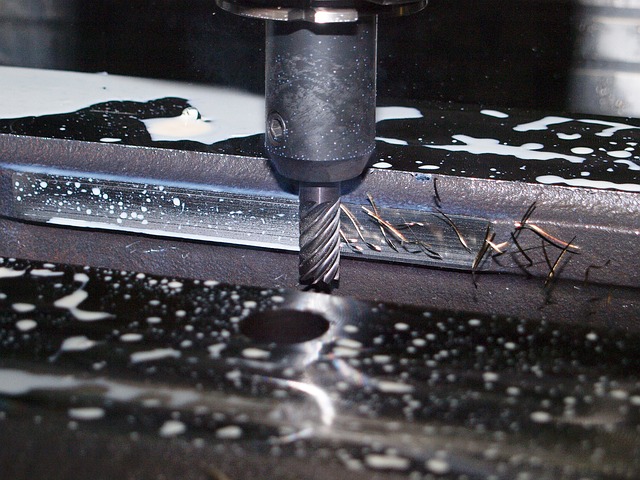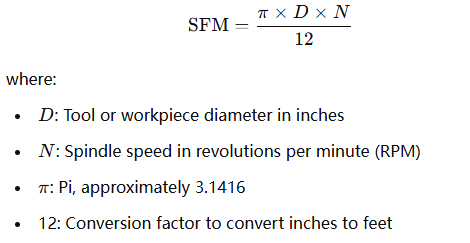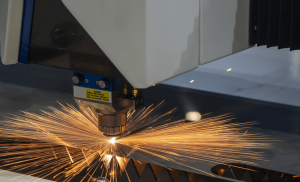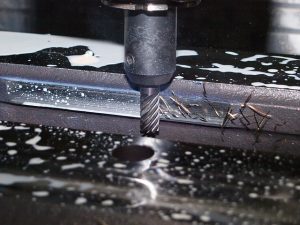In machining, SFM (Surface Feet per Minute) is one of the key factors that determine both efficiency and quality. Setting the correct SFM is crucial for each machining operation, such as turning, milling, or drilling, since SFM directly influences the optimal spindle speed (RPM). To set SFM effectively, consider factors like workpiece material, tool diameter, and cutting conditions to achieve a balance between cutting speed, tool durability, and machining efficiency.
As a standardized measure of the relative speed between the cutting tool and the workpiece surface, SFM helps identify the ideal cutting speed for various materials and tools. By setting SFM scientifically, you can ensure product surface quality, extend tool life, and control machining costs. In real production, adjusting SFM properly also reduces tool wear, increases material removal rates, and enhances surface finish.
This article will explore the definition, calculation methods, and applications of SFM in different machining operations. By understanding SFM’s impact on machining processes and ways to avoid common issues, you can adjust machining parameters more accurately, achieve safe and efficient results, and improve overall production performance.

I. Definition of SFM
In cutting operations, SFM (Surface Feet per Minute) refers to the distance the tool or workpiece surface travels within a unit of time, measured in feet per minute (ft/min). SFM represents the tool’s movement speed across the workpiece surface, regardless of tool diameter or RPM, ensuring a consistent cutting speed. Cutting temperature, tool wear, and surface quality are directly impacted by SFM, making it a key factor in optimizing machining parameters.
SFM finds wide application in various machining methods, such as milling, turning, and drilling. When selecting SFM, consider the workpiece material, tool material, and specific machining method to improve performance effectively and extend tool life.
Importance of SFM in Machining
SFM is essential in many machining operations, including turning, milling, and drilling. Its value should be chosen based on the workpiece material and tool characteristics. Proper SFM settings help enhance machining performance and increase tool longevity, while incorrect SFM can lead to premature tool failure, surface defects, or lower efficiency.
II. SFM Calculation Formula
To calculate SFM accurately, consider spindle speed (RPM) and tool diameter to ensure the relative speed between the tool and workpiece surface meets machining requirements. Below is the common formula for calculating SFM:
SFM Calculation for Turning and Milling
For turning and milling operations, the SFM formula is:

Calculation Example: Using a tool with a diameter of 1.5 inches and a spindle speed of 2000 RPM, SFM would be:

In drilling operations, SFM calculations work similarly to those for turning and milling, but use the drill bit’s diameter in place of ( D ). Typically, SFM values in drilling are slightly lower than in other machining methods to help avoid excessive cutting temperatures and reduce tool wear.
III. Impact of SFM on the Machining Process
SFM greatly influences machining results and tool performance. By selecting an appropriate SFM, machinists can achieve a balanced cutting speed, good surface quality, and longer tool life.
- Determining Spindle Speed (RPM)
SFM directly helps set the spindle speed (RPM) for machining. Different operations require different RPMs, and the choice of SFM determines the RPM range. Based on the required SFM, machinists can calculate the ideal RPM for precise and efficient cutting. - Tool Performance and Stability
Choosing the right SFM optimizes tool performance, preventing issues like tool chatter and workpiece deformation that can arise from improper speeds. This results in smoother operations and improved product quality. - Machinability and Tool Hardness
SFM also plays a vital role in selecting suitable materials and tool hardness levels. For materials of varying hardness, choosing the right SFM helps reduce tool wear effectively and enhances machining performance.
V. The Relationship Between Surface Speed and SFM
SFM is the standardized measurement of surface speed in cutting processes, typically measured in feet per minute (ft/min) or, in metric units, meters per minute (m/min). Understanding the relationship between SFM and surface speed is essential for optimizing machining, as it helps machinists determine the ideal spindle speed.
Role of Surface Speed
Surface speed refers to the cutting speed of the tool across the workpiece surface. As the standardized unit of this speed, SFM enables machinists to select suitable cutting speeds for various tools and workpiece materials, thus achieving optimal machining results.
VI. Expressing SFM in Different Units
SFM can be expressed in two main units: feet per minute (FPM) and millimeters per minute (MM/min). Here are the advantages and disadvantages of each:
Feet per Minute (FPM)
- Advantages: Commonly used in the United States and integrates well with other imperial units.
- Disadvantages: Requires unit conversions for international applications, which may be inconvenient for machinists accustomed to the metric system.
Millimeters per Minute (MM/min)
- Advantages: Well-suited for international and metric-based systems, aligning easily with global manufacturing practices.
- Disadvantages: In the U.S., MM/min often requires conversions, which may be less intuitive for operators used to imperial units.
VII. The Relationship Between SFM and RPM and Conversion Formula
VII. The Relationship Between SFM and RPM and Conversion Formula
SFM and RPM are closely related, with their connection mainly depending on the tool diameter. Use the following formula to convert RPM to SFM:

where DDD is the tool diameter, and 12 is the conversion factor from inches to feet. This formula shows how spindle speed (RPM) and tool diameter together affect surface speed (SFM).
VIII. Recommended SFM Values for Different Materials
In practical machining, different materials require specific SFM settings to achieve optimal results. Below are the recommended SFM ranges for common materials:
| Material | Recommended SFM Range (ft/min) |
| Aluminum | 600 – 1000 |
| Steel | 100 – 300 |
| Stainless Steel | 50 – 150 |
| Titanium | 50 – 100 |
| Brass and Copper | 200 – 400 |
IX. Practical Tips for Optimizing SFM Settings
- Efficient Material Removal: For soft materials like aluminum, a higher SFM can increase efficiency. However, for harder materials like titanium, using a lower SFM reduces tool wear.
- Heat Control: A lower SFM helps control cutting temperature, making it suitable for heat-sensitive materials such as stainless steel and titanium.
- Surface Quality: A higher SFM often improves surface finish, but ensure that the tool material can handle the increased cutting speed.
X. Recommended Tools for Accurate SFM Calculation
For precise SFM calculations, the following tools are highly recommended:
- Machinist Calculator: Designed specifically for machinists, it calculates SFM, feed rates, and other machining parameters.
- Online SFM Calculator: Allows quick SFM calculations by entering parameters online.
- CAM Software: Many CAM programs include built-in SFM calculators, making it easier to create tool paths and optimize machining processes.
- G-Wizard: A popular tool in machining, G-Wizard provides extensive databases of materials and cutting tools, offering accurate SFM and feed rate recommendations.
XI. Common SFM Mistakes and How to Avoid Them
- Unit Conversion Errors: Switching between units can lead to mistakes, so double-check all conversions.
- Ignoring Tool Wear: Adjust SFM for worn tools to prolong tool life.
- Overlooking Material Properties: Match SFM values to the specific material to minimize wear and overheating risks.
XII. Frequently Asked Questions
Can I increase SFM directly to improve machining efficiency?
Increasing SFM can indeed enhance efficiency, but it’s not always suitable for every situation. To find the right balance, consider the workpiece material, tool material, and cutting conditions together. Only increase SFM when you can still maintain tool life and surface quality.
How can I determine if the SFM is appropriate?
You can primarily assess this by examining tool wear and workpiece surface quality. If the tool shows rapid wear or if surface quality declines, you may need to adjust the SFM.
What is the relationship between SFM and RPM?
SFM and RPM are closely linked: RPM controls the rotational speed of the tool, while SFM represents the cutting speed along the workpiece surface. For the same tool diameter, higher SFM requires a higher RPM.
XIII. Conclusion
SFM plays a critical role in machining. Setting SFM correctly ensures efficient, precise operations, extends tool life, and enhances product quality. Adjusting SFM based on material, machining method, and tool type is essential for optimizing cutting parameters and achieving cost-effective production. With the definitions, formulas, and optimization tips provided in this guide, you can adjust machining parameters more effectively to achieve high-quality, high-efficiency production goals. For more information, visit our website; we’re always ready to provide professional assistance.










